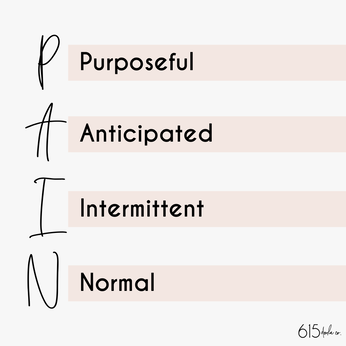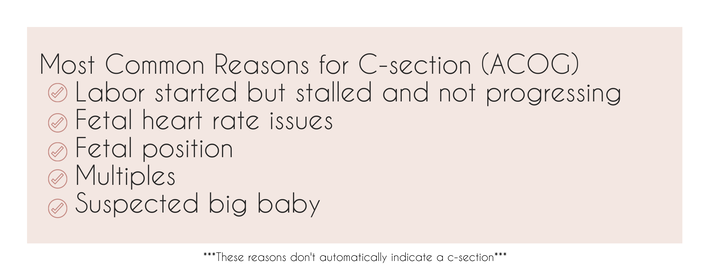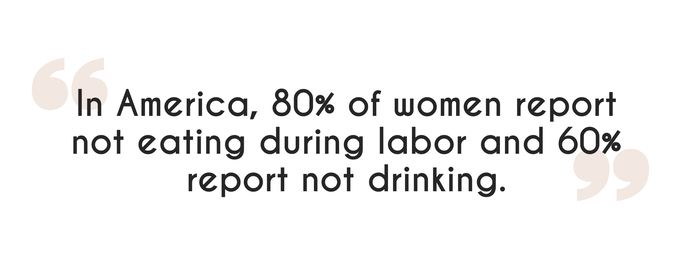 The fear of pain is the most common concern for pregnant people, especially if it is their first birth and they are unsure of what to expect. “How bad is the pain?” or “I don’t know if I will be able to go unmedicated, but I would like to...”, are both common thoughts that I hear from expecting clients who are interested in an unmedicated birth or know that they will experience some labor before an epidural. First things first, it all starts with knowledge. Let’s talk about the sensation or pain you might experience in labor. It helps to memorize this acronym: P: It is not like a charley horse or breaking a bone. It is purposeful. The contraction is doing something very purposeful and productive by opening the cervix, and the uterus muscle is spinning the baby into position, pushing the baby down and out. It is bringing you your baby! A: The sensation is anticipated. Contractions or waves are patterned and they continue to build, so it is not like a scary surprise, but you can sense it building. I: The pain is intermittent, not constant. Unless there is something else going on, you do not feel the sensation of pain in between contractions. These moments in between are nice breaks where you can rest, change positions, communicate, etc. N: The discomfort of labor is normal. The discomfort felt during labor is not cause for alarm, unlike an emergency situation where you break a bone, rupture an appendix, etc. We can normalize the feeling of contractions in labor. Once you have some knowledge around birth, your perception can begin to shift. Many like to re-frame the word “pain” or “contractions”, and prefer to use a word like “waves” or “surges”. I personally call them contractions, but feel that “waves” is a great descriptor because you can feel the contraction building up, peaking, and then falling... like a wave. It then washes away until the next one rolls in. Your only job is to ride the wave, not fight it. I also like to describe it as pure power. It is the kind of power you don’t have to will into existence, instead you have to let it be. It is pretty awe inspiring, and really opens your eyes to what your body can do. The Evidence on Doulas Laboring women report lower pain levels and lower anxiety levels when they are supported by a doula. There is also a decrease in requests for pain medication, and labors are on average shorter with the support of a doula. Pain is a physical reaction. Suffering is an emotional reaction, and can be better understood by education and learning what to expect. Here is a great, short clip from Doula and Childbirth Educator, Penny Simkin, on pain versus suffering. Whether you decide on a medicated or unmedicated birth, it’s important to understand the choices and effects of BOTH options. Below, I have included some popular medications to ease the pain during labor and birth:
The 615 Doula Co Approach As a doula, here are some strategies that I use to reduce pain during labor:
Sources // Evidence Based Birth, National Library of Medicine
0 Comments
 Image via Instagram: @mintandcocoaphoto Image via Instagram: @mintandcocoaphoto The environment of your birth space truly sets the tone for your birthing experience. First, you should ask yourself, how do I want to feel during birth? Do you want the vibe to be spa-like or a more energetic celebration? There is not a wrong answer to this question. It is totally dependent on your personal preference! Research shows that “Creating an environment that helps women to feel safe and secure during birth can improve women's experiences and likelihood of normal birth.” (Royal College of Midwives, 2014). A “private, undisturbed and dark environment, where women feel calm and safe can promote the release of oxytocin, the hormone responsible for uterine contractions and thought to promote the release of the pain relieving hormones endorphins” (Uvnas Moberg, 2003). When this environment is “not achieved, women can experience fear-tension-pain syndrome, impending labour progress and causing increased levels of pain” (Dick-Read, 2013). Here are some tips for creating a calm, spa-like environment in a hospital: During labor and birth, focus and composure are both very important. You may not think of things like beeping, talking, or a subtle hum of a machine as distracting until you are trying to coax a tiny human out of your body 🙂 The 615 Doula Co Approach Little things such as the vibe of your birthing environment might seem tiny in the overall birth plan, but trust me, these details are so significant in the moment. As your doula, I help walk you and/or your family through your birth space desires. We create a step-by-step plan on how we are going to achieve the vibe you want and uphold it in the actual labor space. Sources // Royal College of Midwives, Uvnas Moberg, Dick-Read, National Library of Medicine  First, let me be clear that there is NO ROOM for us to shame or guilt anyone about C-Sections. Birth is birth. However your baby enters the world, I’m here to support! Okay, let’s dive into the good stuff. What is a C-Section? A cesarean or c-section is a surgical delivery of a newborn through a series of 7 incisions through the abdomen and uterus. C-sections can be a life saving surgery and sometimes the safest delivery method, but for low-risk pregnancies, c-sections actually pose greater risks to maternal health and life. Most pregnant people rightfully want to avoid them. The US levels for c-section are currently too high (about 32% of all births). Did you know Doulas decrease the risk of cesarean by 39%? Pros
The 615 Doula Co Approach With all my clients, we sit down together and create a c-section plan in case that becomes the route for your baby to be born. Even with a c-section, you have options, and I am here to help you understand those options and feel confident in the plan that we’ve established. Sources // CDC, Evidence Based Birth, ACOG  Oh the controversial topic of Epidurals... Often, our views on such topics are predetermined due to stories we've heard from family or friends. It's so important that YOU decide what is best for YOUR experience. No matter what you decide, please know that you are strong and capable! Let’s dive into some epidural basics. What is an epidural? An epidural works to significantly reduce pain during labor and delivery, though a sense of intense pressure is often still present. An epidural is a nerve block delivered through a small, flexible tube (catheter) that is inserted into the spine at the small of the back. They are used for both vaginal and c-section deliveries. When given an epidural, a pump is also placed at the bedside so the mother can choose to push the button to receive a controlled boost. Some epidurals are lighter doses and you may still be able to lift your legs while in the bed. With a higher dose epidural you may not be able to move your legs. Your upper body is not affected. You are awake and alert. It takes about 10-15 minutes to take effect and sometimes things have to be adjusted. Pros
IV’s are given with epidurals. IV fluids can cause retained water weight in the mother and baby. If the breast is swollen from fluids, this can impact the baby’s ability to latch for breastfeeding. IV fluids also can slightly increase a baby's weight, so when they naturally lose that water weight, it may inflate how much weight a baby has truly lost and cause some anxiety in mothers and pediatricians. The 615 Doula Co Approach Doula support is correlated with fewer requests for pain medication, however, I proudly support women that are planning for either option! As your doula, I will be right by your side as you and your family make this tough choice. Sources // Evidence Based Birth, DONA, National Library of Medicine, Stanford Study |
Meet Nicki
Hi, I'm Nicki! I am a Nashville based Doula and founder of 615 Doula Co! My favorite part of working as a Doula is supporting families through the life transitions of pregnancy, birth, and postpartum life. Explore Blog |








